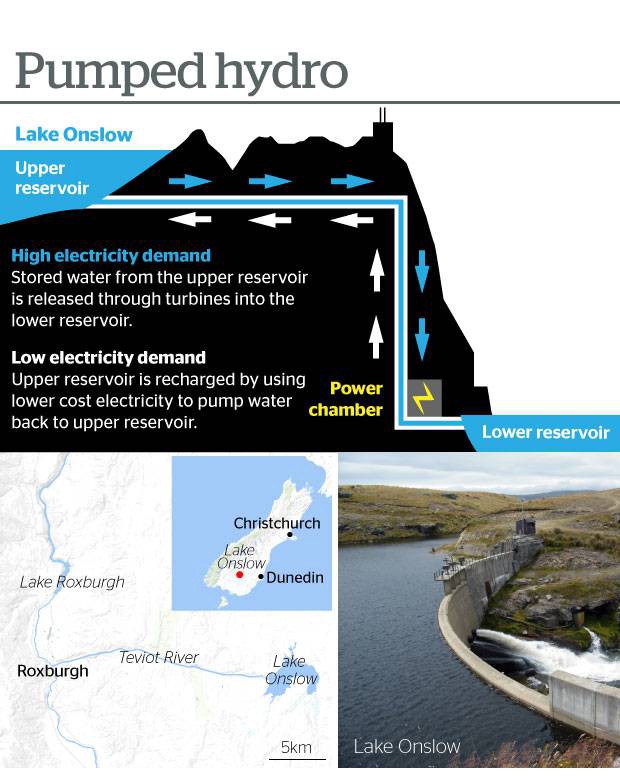Nation-building is back!
Guest post by Brendon Harré.

Readers will know I have been a strong advocate for New Zealand building pumped hydro. For instance, I compiled a very detailed report earlier this year, including a very popular extended comment on the proposed Onslow pumped hydro scheme written by hydrologist Prof Earl Bardsley.
There have been significant developments since compiling that report.
Last weekend the government announced that $30 million has been allocated for developing a business case that addresses New Zealand’s dry year storage problem. This analysis will mostly focus on a pumped hydro storage project at Lake Onslow in Central Otago, but will also include the assessment of smaller potential pumped storage options in the North Island, as well as other alternative technologies.

If the Onslow pumped hydro business case is successful it is estimated construction would take about four to five years to complete, plus two further years to fill the reservoir. There would need to be a one-off energy input of around 2,000 GWh to pump up to a minimum operating level, and perhaps a further 2,500 GWh to increment up to mean operating level. In this sense, closure of Tiwai is helpful if Manapouri power can get across to Onslow. During the construction phase an estimated 10,000 direct and indirect jobs will be created. It will be a multi-billion dollar project, perhaps as much as $5bn if the cost of electrical grid upgrades are included. It would be New Zealand’s largest single infrastructure project since the 1980s.
On the whole, the announcement has received good feedback.
Both the current and a former co-leader of the Green Party — James Shaw and Russel Norman — support the announcement. They believe the environmental benefits to climate change will outweigh local environment effects. Although they do believe the local environment effects need to be fully mitigated against (floating wetlands and creating a large predator free wildlife sanctuary around Onslow have been suggested).
Vector, New Zealand’s largest distributor of electricity, has welcomed the government’s announcement. They state, “as fossil fueled generation plants retire, pumped hydro would provide a smooth and reliable transition to a 100% renewable system alongside customer investments in solar and other technologies.”
Business journalist Rod Oram spoke about the wider climate change and economic picture in an RNZ interview. While in another RNZ interview Prof Bardsley the originator of the Lake Onslow project gave a good summary of the proposed scheme.
Onslow + grid upgrades + smaller North Island pumped hydro can collectively be called the ‘Green Grid’ as a shorthand description.
In the coming years the Green Grid will be very important to a Jacinda Ardern government because it gives practical intent to the statement “climate change is my generations nuclear free moment”.
When the Green Grid is built, Huntly and other peaking coal and gas electricity generation plants will close. Pumped hydro will provide lower cost peaking electricity generation. New Zealand will achieve 100% renewable electricity. This green electricity economy will not suffer the approximate 1-in-10 dry winter risk that would otherwise close down the renewable energy economy. The Green Grid will provide a secure supply of low cost renewable electricity. In a sense it is like insurance that protects the electricity system against variable rainfall i.e. the dry year risk, and against the intermittency of wind and sun.
Pumped hydro will buy electricity for storage when wholesale electricity prices are low and sell electricity for generation when prices are high. This will make wind and in the near future solar electricity generation more financially viable. Thus, it brings forward investment in renewable electricity to match the ‘ramp’ of demand coming from electrifying transport and industrial processes. This being the estimated 70% increase in electricity consumption forecasted to occur over the next few decades.
The Green Grid puts New Zealand on a pathway towards a zero-carbon economy. The Green Grid would be a significant start to a national energy plan covering the next 30 years that the Climate Change Commissioner Rod Carr says New Zealand needs. The Green Grid will provide a positive example to the rest of the world for what is possible. New Zealand can again take the role of being the world’s social laboratory.
Being a early starter in electrifying the economy will give New Zealand firms and workers an advantage in creating and selling globally the products and services needed to maintain the electrified economy.
For instance, New Zealand would be a fantastic place for agritech innovation and development in electrified robotics and machinery. Already electric drones and electric motorbikes have a commercial place in the rural environment. This could be the start of a much bigger transformation of the agricultural sector.
If New Zealand genuinely embraced the 100% Pure brand with practical initiatives, such as the Green Grid, this could reward the country handsomely on many different levels.
The government can currently borrow at exceptionally low cost. Therefore a $5bn price tag for the Green Grid is not as expensive as it appears. If the government debt funded the entire project at 1%, then the interest cost is only $50m a year. If the debt was repaid over a 50-year period in equal instalments, then the capital repayments would only be $100m a year. Note the business case will give a better accounting of these financial costs.
In comparison Transmission Gully will cost the country $125m per year over a 20-year period due to the public private partnership arrangement that the previous government signed the country up to. I believe the benefits to New Zealand from pumped hydro far exceeds Wellington’s motorway project. For a quite modest cost the country gets a clear pathway to a carbon-zero economy that is fully protected from its most significant risk factors.
Yet even this modest debt cost for building pumped hydro could be offset by significant savings in wholesale electricity prices. It is possible that pumped hydro’s arbitrage operations will lower prices to such a degree, that in effect, there is no cost for this climate change initiative.
Dr Keith Turner, the former chief executive of Meridian Energy from 1999 to 2008, has given his professional opinion that if the cost of the Onslow pumped hydro scheme was spread across all electricity consumption, like an insurance premium, it would be only 0.5 to 0.75 cents per kilowatt hour. That is about $50 a year for an average household. Whereas wholesale electricity prices would likely drop by twice this much once the scheme begins operating. Note Turner’s opinion piece is a great read and fully demonstrates how large a nation-building opportunity the Onslow pumped hydro scheme is.
There would be different funding options for the Green Grid. The government could pay the capital and interest costs from the consolidated fund and ‘gift’ the Green Grid, including a completed and filled Onslow. The government could gift it to Transpower who would manage the operating costs and revenues resulting from the buying and selling arbitrage operations on a financially neutral basis (non-profit/non-subsidy over the long term).
In this case, Transpower’s legislated public purpose should be security of supply, lowest possible transmission costs and facilitating competition of supply for new entrant renewable generation. Over time renewable electricity generation is tracking down in price (unlike coal and gas which is tracking up). Facilitating the competitive entry of new renewable generation into the electricity market should result in wholesale electricity prices falling. Which over time should mean consumer electricity prices fall.
More competition is certainly needed in New Zealand’s electricity market. The Electricity Authority recently found Meridian Energy guilty of manipulating the electricity market at a cost of $80m to consumers.
Other funding models could include Transpower gaining the right to borrow like Kainga Ora. That it repays the debt for building the Green Grid by either a higher line charge levy or through its buying and selling arbitrage operations. The second option meaning the effect on electricity per unit charges would be higher than the other counter-factuals. The business case will hopefully determine the overall market effect of replacing high cost peaking coal and gas with lower cost renewables that is fully buffered by pumped hydro.
If needed, low income households could be compensated for higher electricity levy charges, if there were a concern the consumer group were incurring higher costs than benefits, by increasing the Winter Energy payment grant.
Megan Woods the Energy Minister has discussed the business case process, she highlights how pumped hydro will allow New Zealand to take full advantage of its abundant renewable natural resources to produce some of the lowest cost and cleanest electricity in the world.
Whatever funding model the business case lands on I am satisfied the correct process is in place to determine the right option.
Leave a Reply